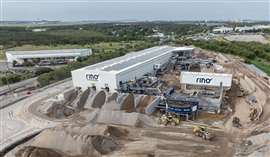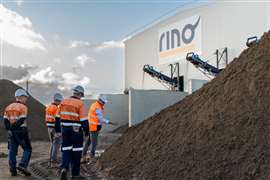Rino Recycling opens hybrid wet & dry waste processing facility
20 November 2024
Australia-based Rino Recycling has opened a construction and demolition (C&D) waste recycling plant in Brisbane, introducing a hybrid wet and dry processing system to support its sustainability efforts in South East Queensland (SEQ).
 Rino Recycling’s new wet and dry processing plant near Brisbane, Australia. (PHOTO: CDE)
Rino Recycling’s new wet and dry processing plant near Brisbane, Australia. (PHOTO: CDE)
According to Rino, the facility—which is designed to process up to 475 tonnes of waste per hour, represents a significant development for resource recovery in the region.
“We truly believe this plant to be one of SEQ’s crown jewels for sustainable construction,” said Rino Recycling general manager Daniel Blaser.
“It’s a beacon of sustainability, not only for this region but for any fast-developing region that recognises economic growth doesn’t have to come at the cost of the environment.”
Located near Brisbane’s Central Business District, the plant is strategically positioned to minimise transportation distances for waste materials, reducing the carbon footprint of local infrastructure projects.
It integrates a wet processing system designed by CDE with a dry recyclables system from Turmec, enabling the processing of a wide range of waste streams, including commercial skip waste, hydro excavation waste, and excavated fills, without manual input.
How Rino’s new recycling plant works
Incoming materials, including commercial skip waste, hydro excavation muds, and excavated fills, are first processed through Turmec’s dry mixed recyclables system. This initial stage separates fines and removes contaminants, preparing the material for further refinement.
The partially processed material then transitions to CDE’s wet processing plant via a network of conveyors. Here, the waste is washed and graded to produce recycled sand and aggregates in various sizes, including 5mm, 10mm, 20mm, and 40/70mm.
The facility operates with minimal operator intervention, relying on a fully automated design to optimise efficiency and ensure consistent output. Additionally, CDE water recycling technology allows up to 95% of the water used in the process to be reclaimed and reused, making the plant water neutral and environmentally sustainable.
The plant, currently operating at 50% capacity, is expected to reach full operational levels by late 2025.
Daniel highlighted Rino’s ongoing efforts to promote recycled construction materials, stating: “We’re making a very strong case in favour of recycled sand and aggregate. More and more are adapting [to using sustainable materials], and as that increases, so too will our capacity to meet that growing demand.”
 The plant produces a wide range of recycled sand and aggregates. (PHOTO: CDE)
The plant produces a wide range of recycled sand and aggregates. (PHOTO: CDE)
According to the Department of Climate Change, Energy, the Environment and Water, C&D waste accounts for 38% of Australia’s total waste.
Utilising alternative and recycled materials instead of virgin quarried materials is a key component of local authorities’ efforts to increase resource recovery in SEQ—a region where the population is predicted to increase 40% by 2041.
STAY CONNECTED



Receive the information you need when you need it through our world-leading magazines, newsletters and daily briefings.
CONNECT WITH THE TEAM






